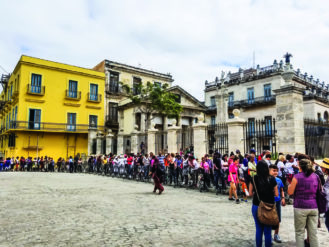
A street in “Habana Vieja,” or “Old Havana.” In the foreground, a family-owned restaurant or “paladar” sells pizzas. Though officially still socialist, since the collapse of the USSR, Cuba has permitted such entrepreneurship. Dining at any of these family-owned businesses constitutes part of your “support for the Cuban people” when traveling to Cuba, and many offer outstanding cuisine. Parked in the street, one of the many pink convertibles used to ferry tourists through the city on sightseeing excursions.

Looking out at the Plaza Vieja and surrounding neighborhood, with the Cuban capitol building in the background.

Havana’s Hotel Nacional, which overlooks the sea, opened in 1930 and has hosted international luminaries and leaders including Winston Churchill, Jean-Paul Sartre, Marlene Dietrich, Ernest Hemingway, Mickey Mantle, and Frank Sinatra.
Seeking to escape the cold and open our children’s worlds in a way that no all-inclusive resort can, we traveled to Cuba. Though the Trump administration in 2017 repealed one of the categories allowing U.S. citizens to visit Cuba, twelve remain, and “support for the Cuban people” dovetailed with our goals.
With our Spanish fluency, we knew we could experience Cuba without the filter of a tour guide. We also sought a slower pace than most organized excursions allow, so we planned our travel independent of any tour companies. Seeking a blend of cultural experiences and beach time, we limited ourselves to two destinations: Havana and Playa Larga.

Interior of one of our renovated historic apartments. To support the locals and give our children a more accurate view of daily life, we booked homes through Airbnb, allowing us to pay in advance with dollars.
Cuba Travel Services sold us our visas right at the United gate in Houston before boarding our Havana flight. The ongoing U.S. trade embargo means that only a few U.S. bank cards function in Cuba, so we bought Euros to avoid the 10% surcharge on exchanging dollars and at the Havana airport converted these to “CUCs” (the Cuban convertible peso reserved for tourists). We breezed through immigration, only cursorily scrutinized by women officials who complement their government uniforms with black heels and lace stockings.

People wait in the Plaza de Armas to take a turn walking around the ceiba tree to make wishes.
Buses and taxis are reliable and abundant, with the bonus that taking taxis gave us many opportunities to ride in 1950s Chevys and Soviet-era LADAs. These rides constituted some of our “support for the Cuban people,” and allowed us to interact with locals more than renting a car would have permitted. We rented a few apartments in historic buildings, to get a feel for different neighborhoods and lifestyles.

Havana will celebrate its 500-year anniversary in 2019, and historic buildings like this one are slated for renovations.
Our first day in Old Havana, a UNESCO World Heritage Site, coincided with the 499th anniversary of the city’s founding. Lines of locals waited their turn to walk three times around the ceiba tree in the Plaza de Armas, a square dating to the 1520s. The tree is strongly associated with Afro-Cuban orishas or spirits, but many of these same devotees later that day appeared in Havana’s Cathedral to petition St. Christopher at his altar there.

A view of the 2018 Havana Marathon from our apartment overlooking the Malecón, Havana’s historic seawall and boardwalk.
The Museum of Colonial Art in the Cathedral’s plaza featured some remarkable everyday objects from the country’s long colonial history—and the sounds of Cuban son from musicians in a nearby restaurant drifted through its open windows. Though we arrived just after its official closing, a guard permitted us to take the elevator to the Camera Obscura, an optical device that offers 360-degree views. From the roof, we could see the Plaza Vieja’s colorful buildings from the seventeenth through twentieth centuries. At Salsabor, the kids and I took a lesson in Cuban salsa dancing. As my 9-year old drummer followed this with a class on the timbales, widely used in Cuban music, we relaxed on a balcony and indulged in drinks with and without Havana Club, Cuba’s ubiquitous rum.

A view from our beach house in Playa Larga, on the Bay of Pigs.
Snorkeling in the calm waters among the pristine coral reefs of Punta Perdíz in the Bay of Pigs offered the perfect antidote to Havana’s nonstop bustle. A beachfront house in sleepy Playa Larga served as our base for exploring the Caribbean side of the island, home to the Ciénega de Zapata Biosphere Reserve with its mangrove and evergreen forests.

Havana’s “coco-taxis” were my kids’ preferred means of transportation in the city.
These rich urban and coastal landscapes only hint at Cuba’s story. It was the people we encountered—of all walks of life, educational backgrounds, ethnic and racial groups—who are without question its richest resource. Our taxi drivers and hosts had worked as teachers, agricultural engineers and in other professional capacities. Despite the hardships they have and continue to endure, they expressed pride in their nation’s heritage, resilience, and independence. They freely shared their views on the country’s sites and history, and its complex relationship with the U.S. Many were bilingual, and all made us feel welcome. Though all too short, our eight days in Cuba allowed us all to see beyond the occasional headlines and connect with the locals to gain a more nuanced view of Cuba today.
Have you taken a trip with the goal to understand and experience another culture? Contact us if you’d like to share your information for our “Cultural Travel” page.
Photos by Andrés Chaparro




0 Comments